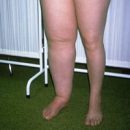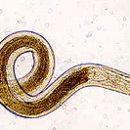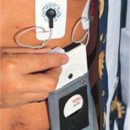Supporting atherosclerosis is the leading reason for the chronic arterial lack of limbs in people over 40 years; The incidence is most high in men 50-70 years. Manifestations of disease, diagnosis and treatment.
Ninema more, prevent disease!
Content
Atherosclerosis of the bottom limb arteries
 Abdominal aorta is the largest artery of a person in the abdominal cavity, carrying blood from the heart to the legs. At the level of the navel, it is divided into iliac artery, which at the level of the groin go to the femur, and then into the popliteal arteries and the arteries of the leg.
Abdominal aorta is the largest artery of a person in the abdominal cavity, carrying blood from the heart to the legs. At the level of the navel, it is divided into iliac artery, which at the level of the groin go to the femur, and then into the popliteal arteries and the arteries of the leg.
The most common cause of violation of blood supply to atherosclerosis (atherotromboosis) - cholesterol deposition in the vascular wall. This leads to the formation of so-called plaques, narrowing or fully closing the clearance of the vessel. Such plaques can both form in the arteries of the legs (femoral, patent and bertic arteries), narrowing and / or clogging them. With a narrowing or occlusion of iliac, femoral arteries, blood does not flow, and oxygen in sufficient quantities in which they need, as a result, the blood supply to one or both legs is reduced as a result. This lack of oxygen is called ischemia, which causes pain. In severe cases, trophic ulcers and gangrene can develop, which can lead to limb amputation. However, it rarely occurs, with the progression of atherosclerosis, and during the neglected treatment.
Symptoms of the disease
In the initial stages of the disease there is pain, muscular spasm, fatigue in the legs when walking. For example, a person passes 100 meters and the bout of pain in the muscles makes him stop, after some time the pain passes and he goes on. Such pains are called «Intermittent chromota». The progression of the disease decreases the distance that can be passed without stopping. Further progression of the disease leads to the appearance of permanent pains in the fingers or foot not only during walking, but also alone. Lack of treatment will lead to the development of the last stage of the disease — Hangrère fingers or feet, which can entail the need for amputation of a sore feet. Amputation in 10-40% of cases leads to death. In addition, after amputation, most patients dies within 2-3 years. Some men, with an occlusion of iliac artery, can also experience erectile dysfunction.
Symptoms that may also meet:
- Heavy pain, numbness in the limb
- Strong wounds on the fingers or the heads
- Peeling of the skin, cracks on the skin, which can become an entrance gate for infections
- Gangrene that leads to amputation
If you have any of the above symptoms, you should immediately contact the vascular surgeon to prevent limb amputation.
Causes of oblumbrant diseases of the arteries of the lower extremities
Atherosclerosis is the main cause of oblique diseases of the arteries of the lower extremities.
Risk factors:
- Smoking
- High cholesterol
- High blood pressure
- Obesity
- The presence of hereditary predisposition
- Diabetes
How to examine
Ultrasonic Doppler with Measuring Shoulder Index. Makes it possible to determine the level of atherosclerotic occlusion and the degree of blood supply to the distal departments of the affected limb.
X-ray angiography. It allows you to determine the localization and length of the pathological process, the degree of damage to the arteries (occlusion, stenosis).
Spiral computer tomoangiography and magnetic resonant contrast angiography is not inferior to X-ray information, but does not require hospitalization and differs in high security for patients, as the contrast is introduced intravenously.
How to treat
Changing lifestyle
One of the fundamental is a refusal of smoking, maintaining a normal weight (there is a non-fat and high protein food). If you suffer from diabetes mellitus, then maintain the normal level of blood sugar, as well as abide by personal leg hygiene (well adapted and soft shoes care from skin damage).
The treatment of atherosclerotic lesions should be complex and continuous. Only this approach allows for many years to preserve the vital and physical activity. Conservative treatment implies a decrease in the rate of progression of atherosclerosis, reducing the risk of thrombotic complications. For permanent reception, it is possible to recommend drugs reduced cholesterol — Statins (for example, Zocor, or other drugs from this group) or Allicor (natural anti-seaterosclerotic drug based on garlic). Preparations are used, extending vessels (verapamil, cylostazol), which improve blood flow and reduce risk formation of thromboms (pentoxifyllin, refooliglukin, aspirin or thromb-ass, Vessel Due F, Kuraltil). With significantly pronounced ischemia, prostaglandinov preparations are successfully used (Alpostan, Vaison). Therapeutic tools give a positive effect only after the multi-month reception, and in such a situation they should be considered as a mandatory addition to surgical treatment.
Surgery
Surgical treatment is shown in a significant decrease in the quality of life due to atherosclerotic lesions. It is to remove an atherosclerotic plaque of the occlusive clearance of the arteries or creating a workaround (shunting). In case of occlusion or stenosis of the iliac artery, aorto-femoral or aortotobi-physical femoral shunting is performed. With the defeat of the femoral artery, femoral-poplinting shunting or profoundoplasty.
Endovascular treatment In the defeat of the iliac artery, angioplasty and artery stenting are successfully used. Angioplasty - a way to expand the internal lumen of vessels with a special cylinder. At the same time, a specialist - an interventional radiologist through a small puncture introduces a thin tube (catheter) and brings to the narrowed vessel portion, under the control of X-rays. The balloon is expanding, spreading atherosclerotic plaques, and the cots on the vessel is restored. In some cases, after that, the metal frame is installed - the stent, which, jumped allows you to save the result.









